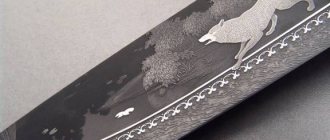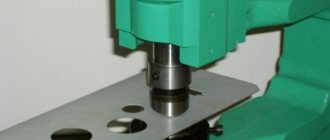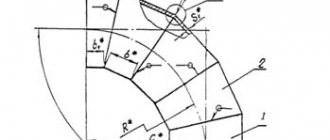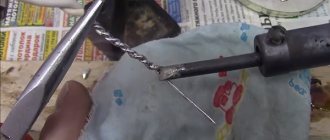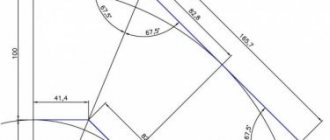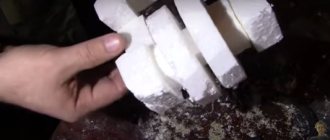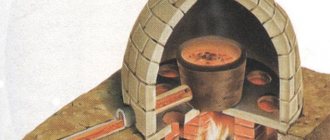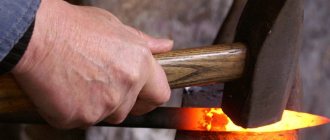Work on stamping and pressing of various workpieces requires the use of special punches. This product is used for marking device components during metal processing or in the stamping process. In order to make high-quality stamping or marking of a device assembly, direct pressure must be applied to it. It is for this purpose that the punch was developed, which can be of very different designs.
Experts identify the following types of such devices:
- cutting;
- punching;
- piercing;
- perforated
How dies and punches work
During pressing, a durable tamping punch exerts strong pressure on a special press washer, which in turn transfers pressure to the workpiece. As a result, the desired workpiece is squeezed out through the matrix. The punch is capable of operating under enormous thermal and power loads, so it is made from wear-resistant metal. The device is very durable and is not damaged by temperature changes.
In other words, a die is considered a device that, using pressure, can produce a workpiece of the required shape and size. When stamping various parts, it is the most important tool. When polyurethane is used together with it, a high-quality matrix is made from it, which will be the response unit of the stamp.
When assembling any type of stamp, the design of this device always completely coincides with the cutting edge of the matrix. In other words, such a product is a closing unit that is capable of creating the upper part of the workpiece. A set of punches is a small press that can efficiently mark or stamp various components. Using this device, it is possible to produce blanks of any size or apply high-quality markings, which can be mirrored or regular.
Punch sets are used in metalworking plants that press iron blanks or produce sheet metal parts. In the construction industry, using this device, you can make aerated concrete blocks that have various voids.
Punches
Punch
– a special device used in conjunction with a matrix in the production of products.
No stamping and pressing production can do without a punch. This part is used for marking parts in stamping and metalworking. To stamp or mark a part, direct pressure is applied to the part. It is precisely for such a technological operation that the punch is intended.
PRODUCTION TECHNOLOGIES
The punch is a special design that matches the profile of the matrix. This is the closing element with the help of which the product is formed from above. The punch performs the function of a press (another name is a press stamp or cotter pin), a stamp or a marking device. The system extrudes the part or applies markings (regular or mirrored), or stamps the parts.
BY DESIGN THE PUNCHES CAN BE:
- Punchy;
- Stitched;
- Perforated;
- Die-cut.
Making cylindrical punches is not difficult. Thus, the blank for such products can be machined, polished, and then grinded. The production of shaped punches is much more complex. Initially, with the help of metal-cutting equipment, the contour of the punch is processed, on the basis of which an impression is made. Based on the finished impression, the punch is processed, further hardened and final processed. The punches are hardened at a temperature of about 780 degrees.
There are specific requirements for the equipment of stamping presses. Not allowed:
- gaps;
- burrs;
- cracks;
- unevenness.
Therefore, when producing cylindrical punches, double grinding is carried out. Roughing is done first and then finishing sanding is done. At the final stage, the part is polished and sharpened.
OPERATING PRINCIPLE OF THE PUNCH
At the moment of pressing, the punch begins to put pressure on the press washer, and it puts pressure on the workpiece, which is squeezed out through the matrix. Since the part operates under high power and thermal loads, it is made of special, wear-resistant steel. It is highly durable and does not deform under the influence of temperature changes.
A punch is a tool that uses pressure to obtain a workpiece of a certain shape. In stamping production it is one of the most important parts.
MATERIALS FOR PUNCHES
In production, the punch is used as a press that forces the workpiece through the matrix. The system operates under high pressure, and during hot processes it is exposed to heat. In accordance with the main purpose, press parts are made from the following materials:
- For cold processes - from high-strength steels with increased hardenability, as well as from tool steels. Materials must have high strength, wear resistance, and corrosion resistance. Alloy steels are not suitable for this type of structure, since after prolonged exposure to high temperatures the steel becomes brittle.
- For hot processes - from wear-resistant steels with high strength at deformation temperatures. This ensures maximum stamp durability.
- Modern polymer materials - polyurethane - are also used. This is an elastic, wear-resistant and durable material with increased hardness - up to 98 units on the Shore scale.
FIELDS OF APPLICATION OF PUNCHES
The main area of application for punches is metalworking, for example, metal pressing, production of construction products (aerated concrete blocks with shaped voids, cinder blocks) and much more.
is ready to offer manufacturing services for punches and pushers at competitive prices.
To determine the cost and production time of punches, send your request through the form on the website or by email
APPLICATION REQUIREMENTS
(Include the following information in your request):
- Drawing or 3D model
- Finished product material
- additional information
The minimum cost of a punch is from 1000 rubles
Punch production time is from 1 working day
Within one business day, a specialist will contact you to clarify details, calculate the cost and deadlines.
If you do not have the required 3D model or drawing, we will help you design and manufacture them.
The main purpose of the matrix
In order to make a workpiece of the required shape, a matrix is used, which can be made from:
- polyurethane;
- rubber;
- various metals.
To make an iron part, the matrix must be made of specialized strong steel, which has high wear resistance. Such a structure should be equipped with polished walls and not have a lid.
Experts distinguish the following types of matrices:
- simple;
- complex;
- universal.
The most complex design solutions are used quite rarely, so they are produced to individual order. An example of simple matrices is molds for the production of various blocks and small bricks.
Stamp and punch
In any stamp, the design of this part always coincides with the cutting part of the matrix.
In fact, this part can be called the closing part, creating the upper part of the product. A punch is a small press that is capable of stamping and marking parts. With its help, you can stamp parts of any shape or apply markings, and it can be ordinary or in a mirror image.
mainly used in the metalworking industry , where metal pressing is used and sheet blanks are formed. In the construction industry, aerated concrete blocks with shaped voids are produced using a punch.
Materials for the manufacture of punches and dies
The main task of a set of punches is to force the part through the matrix. This work is done under enormous pressure. When using hot pressing, the workpieces are exposed to high temperatures. Because of this, different types of materials are used to produce punches and dies. Devices for cold pressing are made from specialized high-strength steel, which has a high degree of hardening.
The materials for the manufacture of these parts meet the following characteristics:
- high degree of wear resistance;
- great strength;
- corrosion resistance.
Alloy steel is not suitable for high temperature applications. Metal can become brittle under the influence of temperature differences. Any punch has the highest degree of hardness over its entire height. In the hot method of manufacturing dies for steel stamping, the upper part of the product is made of specialized metals that are not subject to deformation at high temperatures and have a high degree of wear resistance. This technology can provide the greatest durability of the device. Sometimes modern types of various polymers are used. For example, it could be polyurethane, which has good elasticity and great strength.
Our advantages:
Experience and technical capabilities allow STANKOFINEXPO specialists to carry out the most complex orders for the production of stamping equipment:
- Technological equipment for the full cycle of jewelry, souvenir, and production;
- Flat (D and 2D) dies, dies, punches, molds;
- Volumetric 3D stamps and matrices.
- Orders are carried out according to drawings, part sketches provided by the customer, as well as photographs or ready-made samples.
More detailed information can be found on our dedicated website
https://sfe.su
Main characteristics of the product
Absolutely any type of stamps has a certain warranty period. The main components of this device are the matrix and the punch, which wear out quite quickly. These units must be changed regularly because they can last about 5 years without replacement. The equipment of vibration presses and stamping devices has a different design. This is done so that it is possible to carry out various technical operations.
For this reason, extensive grinding is performed when producing cylindrical dies. Craftsmen do rough processing of the device, and then clean grinding. The device is sharpened and polished at the last stage of its manufacture.
To make shaped punches, a technological impression is used. The device is hardened in a hot oven for 10 minutes. Next, the final sanding begins. To obtain a product of complex shape, a large amount of specialized equipment is used. It is almost impossible to do without the use of milling and planing machines.
Similar equipment is needed for matrix production. When the molds for the press are made of very high quality, and the punch is equipped with an accurate cut line, the stamp will have a high degree of wear resistance and a long service life. Experts believe that making stamps with your own hands is very difficult. To do this, you need to have a lot of knowledge in the field of metal processing.
Types and purpose of produced dies, dies, molds, punches:
- Stamping equipment;
- dies for cold stamping of precision parts produced by cold forming;
- production of a working profile of dies for stamping parts having a round and complex geometric shape;
- impact dies and flat rolling dies for the production of fasteners;
- dies for volumetric forging;
- dies for presses with a swinging punch;
- molds, tools for upsetting and rolling;
- mold inserts;
- equipment for cold and hot stamping;
- parts of complex shapes made of alloy steels;
- parts with a high degree of deformation from difficult-to-stamp metals;
- high-precision fasteners and similar shaped parts (torx, phillips, posi-drive, clutch, hexagonal socket);
- dies and punches for making fasteners and forming holes and fastener bolt heads;
- pressing and injection molding equipment for the manufacture of machine parts of complex spatial shapes.
- dies for making airfoil profiles and locking parts of blades for turbines and compressor blades;
- matrices for applying microrelief to the surface;
- stitching high-precision holes in products of complex configuration;
- forging dies for the automotive industry (CV joint race parts, end coupling die, spline connection, gear die, etc.);
- various elements of a mold for the manufacture of parts for pneumatic and hydraulic equipment;
- forming surfaces of dies, punch equipment and molds for the manufacture of medical instruments, implants, scalpels and other things;
- molds for consumer goods and electrical goods;
- cutting dies for jewelry and souvenir production, jewelry stamp and matrix;
- production of piercing punches for contour windows in a matrix;
- production of foundry molds for jewelry and pendants;
- embossing dies for jewelry production;
- forming surfaces of matrices for heraldry, costume jewelry, jewelry production, jewelry stamp and matrix;
- stamping equipment for heraldry, costume jewelry, jewelry production;
- stamps and matrices for souvenirs, tokens, key rings, clips;
- matrix and punch for making obverse and reverse (male/female) large and small souvenir coins;
- stamping equipment for cutting and shaping (embossing) presses in the production of: military paraphernalia, cockades, buttons, insignia, insignia;
- stamps and matrices for the production of medals, orders, award signs, and other heraldry;
- equipment and dies for jewelry and jewelry elements;
- production of basma stamps, church utensils, stamps for crosses, icons, church-themed products;
- stamps for restoration of antiques and recreation of cultural and historical heritage;
- production of military historical reconstruction.
Press form
Manufacturing a matrix for a press has its own characteristics and requirements. The future form depends on them.
- For the press, split molds are most often made.
- To give a round shape and punch holes, round products are used.
- To make a sheet metal part three-dimensional, molding dies are used.
- If a part requires metal bending during operation, bending dies are used.
Matrices differ in appearance and purpose:
- come in the form of a circle;
- rectangle;
- merged;
- collapsible;
- profile.
When making a matrix, it is very important to choose the right metal. The hardness of the metal should not be less than 57-65 HRC. Depending on the field of activity, different types of metal are used:
- Low-carbon hardened steel is used for the production of small batches of parts.
- Hard alloys - tool or alloy steel, carbon steel is used in mass production.
- High alloy steel is used if there is no heat treatment.
Manufacturing Basics
To make punches to order, the first step is to prepare a workpiece. After this, the object is polished and hardened. If necessary, the profile is sharpened to suitable values. The easiest way to make a cylindrical punch. The ease of the process lies in the fact that the workpiece can be pre-processed, which significantly speeds up the entire process.
Using metal-cutting equipment, the contour of the spare part is processed, and on its basis an impression is made, according to which the master performs the remaining work: hardening, processing. If you need to make a complex contour, you will have to use several types of equipment. For example, to produce products with a flange, you will need to use a milling machine, and for a punch with shoulders, you will need to use planing machine equipment.
Hardening is carried out at a temperature of 7800C. It is important to adhere to established norms and rules, otherwise the surface of the workpiece may be subject to deformation. Numbers or letters can be applied to the product in direct or mirror image, depending on customer requirements. The production of punches with complex contours is carried out on a coordinate drilling machine. At the end of all technological processes, the product is polished.
What you need to know about the production of dies for sheet bending machines
Dies for press brakes can be made from both steel and aluminum alloys. The product must be polished and hardened in accordance with the technological process requirements for the production of molds. Hardening of steel alloys can be done using a fiber laser machine.
The working surfaces of the equipment are additionally hardened to 55-60 HRC through the use of high-frequency induction heating. The steel grades used for the manufacture of dies are selected based on the material of the final products and the conditions of use of the equipment. For inserts, as a rule, alloys of grades C45, C50, 42CrMo4 are used, and in some cases steel 1.2312.
Manufacturing process
The matrix manufacturing process must be calculated very accurately. The quality of the future part depends on this. All work is carried out according to drawings. Each stage must be done professionally.
- First, the shape of the workpiece is obtained on a press or using high temperature.
- The shape is then processed by specialists on a lathe.
- The next stage is finishing and heat treatment.
- The last stage is chrome plating of the working surface.
Making a matrix is a complex process. The work performed by specialists on equipment plays an important role. The accuracy of the product depends on their qualifications. Grinding machines are used for this. Hardening during the manufacturing process is of great importance in the manufacture of matrices. This gives the workpiece ductility and strength.
The easiest forms to manufacture are those that represent bodies of rotation. The work is performed on CNC milling machines, which makes it possible to make precise dimensions and improve quality.
It is important to choose the right material for making the part. The cost and quality of the product depends on this. Soft metals, copper, bronze are not suitable for making matrices. Our company’s specialists will help you understand all the nuances of making a custom matrix.
What is the matrix for?
To obtain a specific product shape, a matrix is used, which can be made from a wide variety of materials:
- steel;
- polyurethane;
- rubber.
For the production of steel blanks, the matrix material is special high-strength steel
, increased wear resistance. This design always has walls without a lid.
The matrix can have several types of design:
- simple;
- complex;
- combined.
Particularly complex designs are rarely used; they are made to special order.
The simplest matrices can be found in the manufacture of hollow bricks and blocks.

